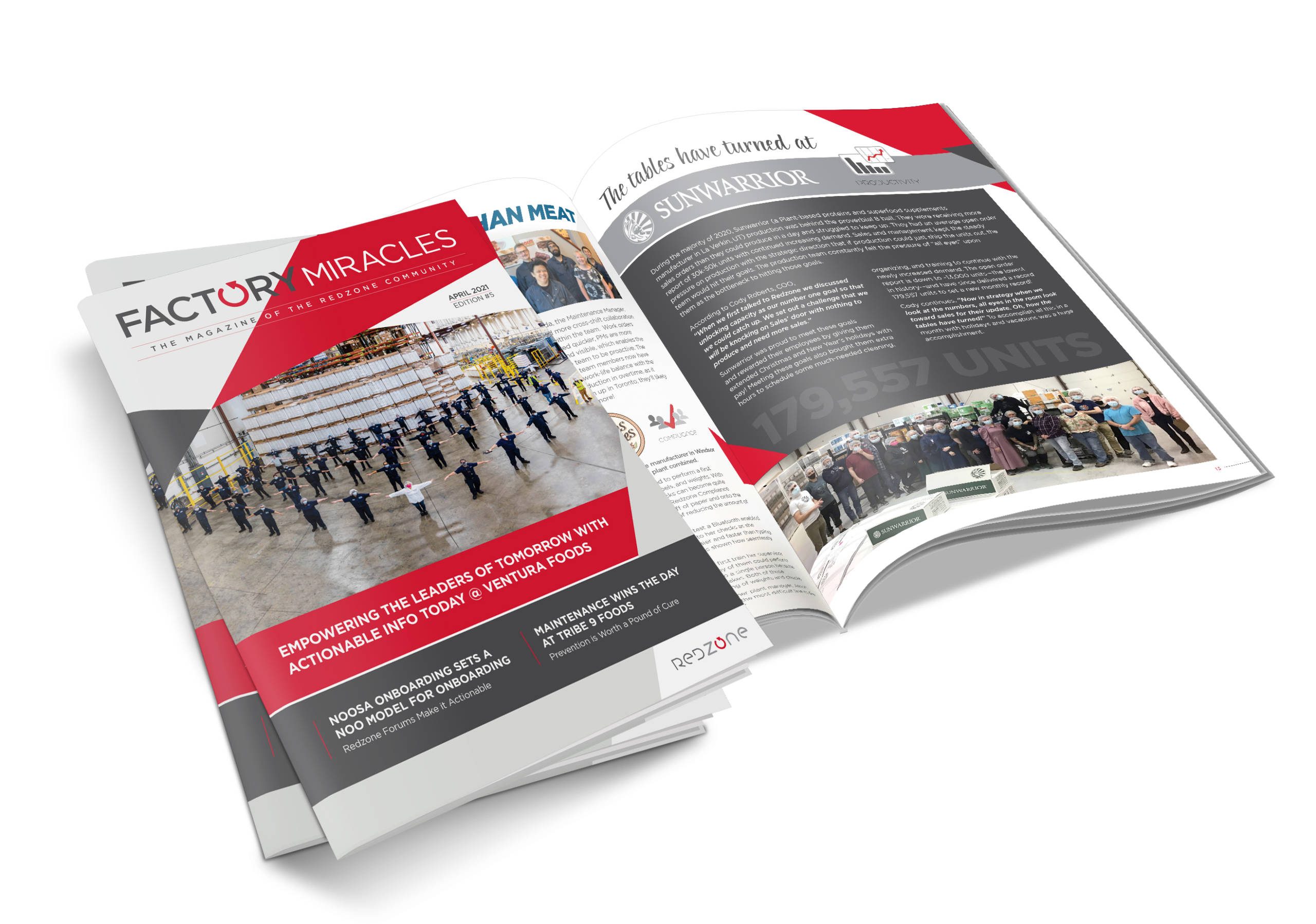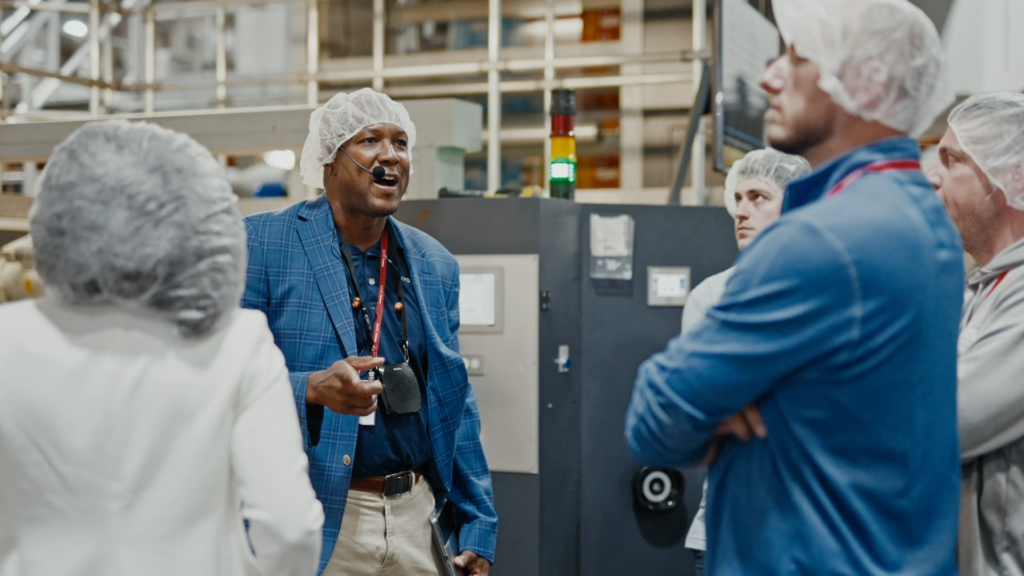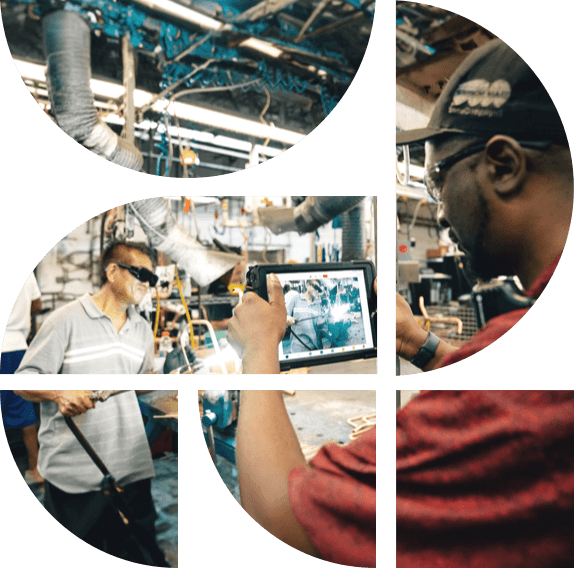Unlock the Secrets to Increased Productivity with Redzone's Newly Released Benchmark Report! Download Today

As in each issue, the Factory Miracle cover story honors a Redzone award winner from the prior year. In this issue, we highlight the first win for Ventura Foods at their Chambersburg, PA plant. First, because the overwhelming sentiment from this team of leaders was characterized by QA Coordinator, Kathleen (Kate) Miller: “It’s a very rewarding accomplishment, but I think it’s just the beginning for us. I think it’s just a start. We can do a lot more and we’re going to get even better.”
Chambersburg was the first of twelve Ventura plants to launch with Redzone. Led by OPEX Manager, Ed Czarnecki, Kathleen, CI Engineer Tim Berkstresser and Quality Coordinator Amanda Bays, this Team of the Year for the Eastern US went from their proof-of-concept—posting an impressive 20% productivity improvement in 90-days—directly into the Redzone Compliance module and have since chalked up an additional 10% productivity with a reduction of on-hold product by 89%. Yet another first for Ventura, they were the first to deploy the new Redzone Date Code Validation where we will learn later how they’ve leveraged this feature. As any large manufacturing plant knows, deploying a new production platform across 37 lines is no small feat, and the team at Chambersburg took their role as trailblazers for Ventura very seriously.
They knew they were the most complex site in the Ventura plant network and that the new procedures and standard work needed to be relevant and easily adopted by the frontline workers. So they went right down onto the floor to get the frontline perspective firsthand. They set out to leave no stone unturned in making the lives of operators easier so there were no bad ideas. This fail-fast-forward philosophy netted tremendous results and achieved their goal of rapid adoption in spades.
Before Redzone, the floor was rife with paper and according to Tim, frontline teams were spending much of their time “dotting ‘I’s and crossing ‘t’s” instead of making the product and processes better. Having started as a Quality Technician, he conveyed the old process of Package Appearance that entailed what he called arts and crafts where they were to cut out the pieces of packaging, tape or paste them onto a piece of paper with all the necessary information and send off to someone else who entered all of that information into the computer. Those sheets needed to be checked by supervision as they were used on the floor for QA checks for each production schedule. The art still needed to be filed, so techs would end their day filing packets of 7-10 pages from across the shift. And as with most paper processes, it was a challenge when an auditor called up one of those checks because, of course, someone had to pull that paper and reconcile it with the actual production run in question.
Now the team has all production and quality data stored digitally in Redzone, so not only is the original information stored, any subsequent need for that data is accessible with a few clicks on the iPad. This, in Tim’s words, “Took us from a quality control (QC) function—checking other peoples’ stuff—to a proper quality assurance (QA) type of job.”
“What’s really important here,” Ed adds, “is the ability to get to the data when we need to. I get phone calls from quality morning, noon and night and even on the weekends asking ‘Hey, somebody said something was wrong with this run. Can you look it up and tell me what we’re doing?’ I can easily pull it up; pull the report and email it to them in five minutes. So, it’s not what I see in the artwork, it’s all the data. All the data they need is in the system.”
Matt Stowell, Production Supervisor weighs in, “The vision for this plant and the frontline supervisors, is to be more analytical in our work and more continuous improvement focused. Now, it’s night and day. We pull up the data, analyze the information and off we go.”
And data they have… According to Ed, “We produce roughly 1600 SKUs with 285 variations of 56 different date codes. That was a big issue for us. With the addition of Redzone, we created between 10 and 12 thousand characteristics to fulfill our customer requests for Best By, Shelf Life and the like. In fact, we’re up to 15,000 characteristics now. With that much variation, we wanted to make it easier on inspectors, so we use blind code dates in the background in Redzone, and they roll out at the appropriate times to match the run.
Now, operators type in the information stamped on the box and if it doesn’t match the codes in Redzone, we know right away. No more stopping the line for a first case check. No more arts and crafts! In the past, we may have run for a whole shift before realizing we were using the wrong dates.”
Kathleen weighs in, “I’m highly involved when we have customer audits or even an SQF audit, and just having Redzone to bring up and show all of our quality checks makes us confident in the data that we show the auditors. I think that helps the confidence on the floor that everybody is entering in the right data.” “Audits will make you nervous.” Added Karen Cornett, QA Manager. “They get you all hyped up and worried. ‘Are we going to find the paper? What are they asking for?’ We don’t have to worry about that anymore. In fact, it’s only a matter of minutes to pull up a SKU, a date, or a line. Everything is already right where we need it.”
You can imagine how proud the team is to have created such an innovative process with a brand-new feature of a brand-new product. Proud enough to shut down the plant for the socially-distanced cover photo! “I was really excited to hear we had won a Redzone award.” Said Jamie Gearhart, A-Team Team-Lead, “It was refreshing because we all worked so hard and pulled together to really accomplish something. Coding errors were one of our biggest problems before Redzone. The operators really love that if they make an error, it is automatically caught, and they can fix it right away before producing bad products.” Crystal Selak, QA Team-Lead for the A-Team adds, “It felt really good being recognized as the flagship plant for Ventura. I know how much we contributed to the company’s improvement by just suggesting, ‘What if we try this? It might be better.’ I mean, there was so much paperwork and different people did their artwork in different ways. Now, everything is so much more organized. It’s either right or it’s wrong.”
And not to be left out, Carla Ryder, another A-Team Team-Lead shared her thoughts: “It was nice to win the award and was kind of shocking to me to see how much we implemented in such a short time. In the past we never knew if people were doing their checks properly, but now you’ve got the data you need in front of you and the data in Redzone to know you did it right.” “I would say that there are a lot of key players in the plant here,” adds Donnie Hughes, Operations Manager. “Many have been very involved with developing Redzone throughout the whole process. You really see the pride, the self-worth, in those people out there. The award meant a lot to them. It was actually pretty amazing in here that day.” “And you see that pride whenever we send them a high five or a good catch,” adds Carla. “If they do something special and don’t get the recognition, they let us know.”
With this broad alignment across the team, you can see why they won a Team of the Year award, but that isn’t the half of it. To truly implement a new solution at this scale takes a village and that is how Ventura approached it. They saw the value of everyone-to-everyone communication so took advantage of it. Matt explains, “The ability to communicate more digitally has really opened up a lot of doors and I only see that increasing. We get a lot of input from the floor because now they have a voice and they no longer have fear or anxiety about raising an issue. It has really paved the way for more solutions.”
And the solutions have come bi-directionally between the implementation team and the floor. Tim explains, “I’ve never let best get in the way of better. But I think one of the people that proved that to me was Ed, because his strategy was, ‘Just do it and let’s see if it works. If it doesn’t, we’ll fix it.’ And that’s how we did it. We went out, we started doing stuff and there’s a lot of stuff we did two or three times until we got it right. I share Kathleen’s opinion, that we have just scratched the surface on what we can actually do, especially what we can allow the people on the floor to do. I think the frontline teams have gone from being reactive and have now transformed into being more proactive—and not just with Redzone, but with everything.”
“One of the things I really like is that I get to see all the chat room activity.” Says Eric Varner, Operations Manager. “As a manager, you look at what people are typing and see what’s going on. You can see the chats on first shift, on second shift or on A-B-C-D teams. We’re a 24/7 operation, so it’s nice to have that feature in there. And each one of them can communicate amongst themselves, plus we can see it.” “And across departments,” adds Karen, “so it’s not only just processing, production, or QA. Now we’re all communicating. That’s made our efficiency even better than what it was before, because now we’re talking, and we can see everything in real time.”
Ed weighs in, “There’s so much more opportunity just to standardize and improve. As you’ve heard, a 30% productivity improvement is only the beginning for us. We just need to continue to remove the roadblocks for the people on the floor to make it easier for them to succeed. The easier I can make their job, the happier they are, the more likely that they’re going to come to me with ideas. I get five to six emails a day—even on the weekends. Now the floor teams are suggesting the improvements, where in the past it was more of a push. So overall, our culture has really improved. Communication is key to everybody and working through the process by getting everyone’s feedback—both ways—from the floor, all the way up to the plant manager. We have the data to empower management decisions. And we have the data to see who our up-and-coming leaders are. And that gives us tremendous confidence in what we can do in the future!”
Twice the Frontline Engagement: Priceless A spring in the step, a smil...




Contact us and let's begin empowering your frontline and growing your bottomline.
